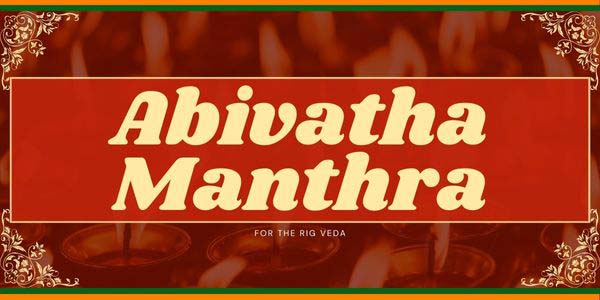“Abhivadanam” is the traditional Vedic way of paying respect and introducing oneself to elders. A typical Abhivadaye Mantra is given below: –
अभिवादये वासिष्ठ मैत्रावरुण कौण्डिन्य त्र्यार्षेय प्रवरान्वित कौण्डिन्यगोत्रः आपस्तम्बसूत्रः यजुश्शाखाऽध्यायी श्रीनारायणशर्माऽहमस्मि भोः
Abhivaadaye vaasisht’ha maitraavaruna kaund’inya tryaarsheya pravaraanvita kaund’inyagotrah’ aapastambasootrah’ yajushshaakhaa’dhyaayee shree naaraayana sharmaa’hamasmi bhoh’
You can break Mantra into the following parts.
Abhivadaye: I am saluting you.
Kaundinyagotrah: I belong to the Kaundinya gotra.
Vashishta Maitravaruna Kaundinya Trayarsheya Pravaranvita: Names of the three Rishis who started Kaundinya Gotra.
This is called the Pravara of the gotra.
Apastambasutrah: the Grihya sutra which I follow.
Yajusshakhadhyayi: I learned Yajurveda
Shri Narayana Sharmahamasmi: I am Narayana Sharma (my name)
Bhoh: Similar to Sir in English.
The introduction comprises of one’s own:
- Gotra
- Pravara of the gotra
- Veda
- Grihya sutra
- Name
What is Gotra?
Gotra means a clan, lineage, or sub-caste.
Gotras are named after Rishis.
They were originally attributed to the Saptarshis.
But Gotras have subdivided into many more.
According to Matsya Purana, seven Rishis came out of the fire when Brahma conducted a yajna.
They were:
- Bhrigu
- Angiras
- Marichi
- Atri
- Pulaha
- Pulastya
- Vasishta
Out of these, Pulaha created Rakshasa.
Pulastya created Pishachas.
Vasishta died and was reborn in the family of Marichi.
All Brahmins have their origin from Bhrigu, Angiras, Marichi, and Atri.
Eight Rishis are considered to be the founders of gotras.

They are called Gotra-karas.
They are:
- Jamadagni – descendent of Bhrigu
- Bharadwaja – descendent of Angiras
- Gotama – descendent of Angiras
- Kashyapa – descendent of Marichi
- Vasishta – descendent of Marichi
- Agastya – descendent of Marichi
- Atri – one of the original
- Vishwamitra – descendent of Atri
Thus originally, there were only 8 gotras.
But then, there were some families who had taken up Kshatriyas.
They later came back and there were 10 more gotras.
They connected to Bhrigu and Angiras gotras.
They are:
- Veetahavya
- Mitrayu
- Shunaka
- Vena
- Ratheetara
- Mudgala
- Vishnurviddha
- Harita
- Kanva
- Sankriti
Thus making it a total of 18 gotras.
What is Pravara?
They are the names of the remotest most important Rishis of that gotra.
There are Pravaras with 1, 2, 3, 5, or 7 Rishis.
There can be multiple Pravaras for the same gotra depending on which and how many Rishis’ names are taken.
Pravararas of Jamadagni gotra
Jamadagani’s genealogy.
A.Bhrigu
B.Chyavana
C.Apnavana
D.Urva
E.Richika
F.Jamadagni
Some of the different Pravaras are:
- Bhaargava – Chyaavana – Aapnavana – Aurva – Jaamadagnya (A, B, C, D, and F)
- Bhaargava – Aurva – Jaamadagnya (A, D, and F)
- Bhaargava – Chyaavana – Aapnavana (A, B, and C)
The Pravaras may include Rishis later than Jamadagni such as:
- Bhaargava – Chyaavana – Aapnavana – Aartishena – Aanupa
- Bhaargava – Chyaavana – Aapnavana – Aurva – Baida
There are a few more. Similarly the other gotras also
Veda Shakha
Vedas are divided into four – Rigveda, Yajurveda, Samaveda, and Atharvaveda.
Each family traditionally has one among them as their primary Veda.
This is the Veda they have to learn first.
Grihya Sutra
Grihya Sutras are books detailing procedures of various rituals such as upanayana, and marriage.
For the same Veda Shakha, there can be different Grihya sutras.
Rigveda – Ashwalayana, Kathyayana, Sankhyayana, etc.
Yajurveda – Apastamba, Bodhayana, etc.
Samaveda – Drahyayaa, Latyayana, etc.
Atharvaveda – Kaushika.
The Procedure
While saying Abhivadaye Mantra, the palms of both hands are held open near the respective years.
After saying the mantra, with your right hand touch the right foot of the person whom you are saluting.
With the left hand touch the left foot.
This is done together.
The right-hand crosses over the left hand.
The right hand should be on top.
Then as per tradition, you can also do a sashtanga namaskara.
The Blessings
The person who is being saluted saying –
आयुष्मान् भव सौम्य
Aayushmaan bhava saumya
The saluting person’s name also can be used in the place of Saumya.
Benefits of doing Abhivadanam
- Earning the blessings of the person saluted.
- Remembering one’s own great lineage.
- Taking the names of great Sages.
